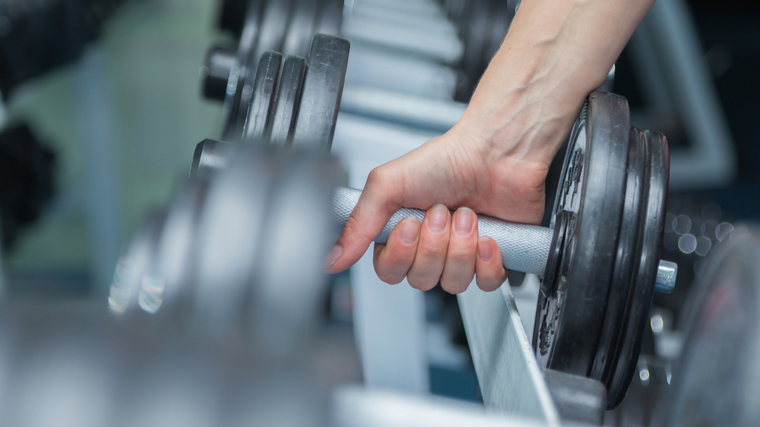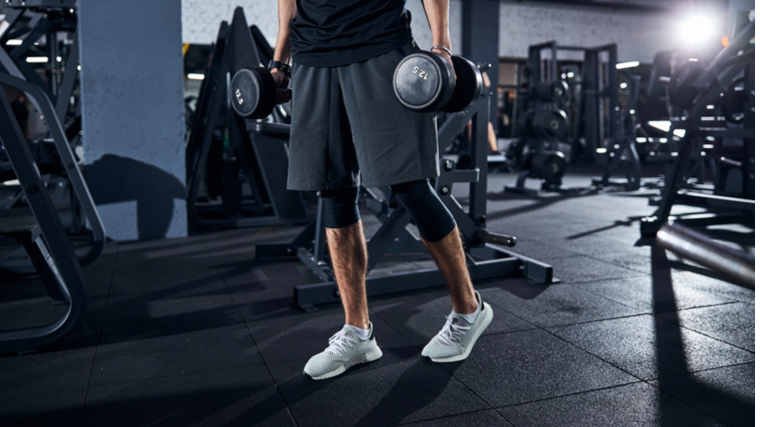One of the most popular exercises in the fitness community is the barbell deadlift. It’s performed in both powerlifting competitions and at the CrossFit games. Chances are you see them almost every day in the gym. That’s probably because the deadlift — and its many variations — is a field-tested exercise that builds strength, muscle, and grit.
If you’re in love with the barbell, power to you. However, if you’re in the mood to change things up but still want to reap the benefits afforded by an exercise considered to be weight-training royalty, head to the dumbbell rack for your next set of deadlifts.

You might be surprised at the unique ways in which dumbbells can help with both your barbell lifts and your everyday life. Keep reading to find out why dumbbell deadlifts might just be the training reboot you never knew you needed.
Benefits of the Dumbbell Deadlift
- Increase Muscle Mass
- Boost Grip Strength
- Fix Muscle Imbalances
- Extend Range of Motion
- Beginner-Friendly
- Increase Stability
- Improve Posture
Increase Muscle Mass
The traditional deadlift is great for building overall strength and power, but the dumbbell deadlift is especially suited for hypertrophy. Hypertrophy, or muscle growth, results from periods of high stress and mechanical tension, provided you refuel and recover sufficiently. This results in increased muscle mass in the muscles worked by the deadlift: glutes, hamstrings, quads, lats, core, traps, and lower back.
By using dumbbells to perform a deadlift, you can generally knock out reps with more tension on the target muscles and a greater range of motion. Although you may not use equally heavy loads as you would when lifting with a barbell, you can bust out more reps while keeping your muscles engaged the whole time.
Boost Grip Strength
A strong grip affects everything you do inside (and out of) the gym, and the dumbbell deadlift can help improve it. Since you’re typically performing more reps in the dumbbell deadlift than with a barbell, more stress is put on your grip, providing a stronger stimulus.
Taking hold of your training requires an airtight grip, and the dumbbell deadlift is a great way to get that work in.
Fix Muscle Imbalances
Possessing equal strength on the right and left sides of your body is crucial for weightlifting, especially in moves like the clean & jerk. If you have an unwelcome muscular imbalance, implementing dumbbell exercises is a great way to address the issue, as your stronger side can’t pick up the slack for your weaker side.
Research indicates that, even in elite-level strength athletes, the use of tools and techniques that challenge each side of the body independently can positively affect strength gains and muscle mass. (1)
Extend Range of Motion
Aside from proper technique, a sufficient range of motion is essential for effective weight lifting. Since you’re not limited by the size of the weight plates, dumbbells allow for a greater range of motion in the deadlift. All things kept equal, an extended range of motion is positively correlated with more potential for muscle growth — an idea strongly backed by scientific evidence. (2)
Beginner-Friendly
If you’re a novice lifter, the barbell may seem intimidating. Fortunately, the dumbbell deadlift retains most of the same benefits as the barbell while being more appealing to beginners and accessible in general.
Dumbbells also come with the extra perk of being fantastic for training bodily coordination and proprioception, qualities that beginners should devote extra attention to. And if you’re just starting your strength journey, dumbbells allow you to work out with pretty light weights if desired.
Increase Stability
Being sturdy and stable from head to toe is imperative if you want to lift properly and make progress. Fortunately, the dumbbell deadlift helps one to excel in this area. Research backs the supposition that dumbbell training increases core activation and involvement of stabilizer muscles. (3)
Stability definitely comes into play in the gym, but also when you’re trying to bring all the groceries in one trip. The dumbbell mimics real-life movement patterns which can improve your day-to-day lifestyle.
Improve Posture
The deadlift is notorious for not only building stronger legs but a stronger back to boot. When performed properly, the dumbbell deadlift targets your traps, the muscle that extends from your neck down through your mid-back. The traps have the essential job of stabilizing the spine and keeping it lined up properly.
Another large muscle the deadlift targets is the erector spinae. These run along your spine and are responsible for keeping the lumbar spine in alignment. It goes without saying that all deadlifts provide some awesome core training as well. By strengthening these integral muscles, you can help prevent slouching and may even positively influence back pain.
How to Do the Dumbbell Deadlift
Just like the conventional barbell deadlift, proper form is crucial for effective results and helping to avoid injury. Follow this step-by-step guide to start dumbbell deadlifting like a pro.

- Grab a pair of dumbbells appropriate for your fitness level — it is best to start light and increase in weight as you refine your technique.
- Stand with your feet under your hips and your shoulders compressed and slightly retracted.
- With a tight core and flat back, push your hips back to hinge over and bend slightly at the knees to lower the weights to the floor.
- Descend until the dumbbells touch the ground (or an elevated surface if you don’t have the flexibility yet).
- Press through your heels to reverse the motion and return to a tall standing position.
Dumbbell Deadlift Tips
Now that you know how to perform the dumbbell deadlift and maybe even did a couple of bodyweight reps to practice, it’s time to get into the nitty-gritty details. Getting the small things right can pay off in a big way when it comes to any compound movement you perform.
Hinge Properly
An all-too-common mistake people tend to make with the deadlift is bending over at the spine. It is absolutely crucial, for safety and efficacy, that the movement in the deadlift comes from the hips instead of the back.
If you’re hunching over on every rep, you’re almost certainly leaving gains on the table and even possibly putting your body at risk.
Stay Tight
You keep hearing the phrase “keep your back flat,” but perhaps you’re not sure what that feels like. Imagine there’s a pole running from your head to your hips. Your goal is to keep that pole in a straight line, meaning your back should be rigid and straight throughout.
Mastering the hip hinge and strengthening the muscles in your back and core will help keep your spine locked in so you can lift heavy and train hard.
Keep the Weights Close
Another important cue for the deadlift is to keep the dumbbells close to your body, almost like you’re shaving your legs with the dumbbells. If the dumbbells drift out from the body, the exercise quickly becomes much, much more difficult to perform safely and effectively.
Keeping the load close to the muscles that are working is a good habit to get into on every exercise, not just the dumbbell deadlift.
Dumbbell Deadlift Variations
The deadlift is arguably one of the most popular exercises in the gym, and lucky for you, there are plenty of ways to do them. If you’re looking to work different muscles, practice your balance, or just switch up your workout, check out the variety of movements below.
Sumo Deadlift
The sumo deadlift is known for its iconic ultra-wide stance and, while typically done with a barbell for powerlifting purposes, can be performed just fine with a pair of dumbbells. It may also serve as a back-friendly alternative to the conventional dumbbell pull, as you should be able to maintain a more upright torso throughout.
Romanian Deadlift
The Romanian deadlift is identical to a standard deadlift save for one major factor — the weights you use cannot touch the floor.
By not placing the weights on the ground during the set, you can zone in on muscle fatigue to a greater degree on each individual repetition. Since the Romanian deadlift generally requires more movement at the hips and less at the knees, it can help improve hip mobility, which can benefit movement patterns like squatting or running.
Single-Leg Deadlifts
As with any unilateral movement, the single-leg deadlift can help improve balance and stability. This variation behaves just like a standard deadlift but requires more core strength to keep your body stable and can improve muscle imbalances, specifically in the hip complex.
Staggered Deadlift
If you’re still working on your balance, the staggered deadlift is a good progression exercise to build up to a single-leg deadlift. You can still reap the unilateral benefits, but with more overall stability since the back foot remains planted on the ground behind you at all times.
Snatch-Grip Deadlift
This variation is actually what it sounds like, a deadlift done with a snatch grip. A snatch grip is wider than shoulder-width and requires both exceptional hamstring flexibility and an extra-strong grip (or a good pair of straps).
That means the snatch-grip deadlift is more difficult and should be performed by more advanced lifters. However, the back, forearms, and grip muscles all work overtime here, so it is a great way to turn up the intensity on your back workouts.
Resistance Band Deadlift
The best part about this variation is it can be used as a supplement or as a replacement to your regular deadlift. To make your deadlift more challenging or even help improve technique, add a resistance band to your weighted deadlift. If you don’t have access to weights, you can add a resistance band just use the resistance band and still target the same muscles just with less impact.
If you don’t have access to weights, a resistance band can get the job done in a pinch. While you’ll obviously lack the overall resistance needed to develop maximal strength, resistance band exercises can come in clutch if you’re traveling or want to practice your deadlift technique at home.
Final Word
There’s a reason the deadlift is seen in commercial gyms and CrossFit competitions alike. It is a fundamental expression of full-body strength that every athlete should have some degree of familiarity with.
That said, there’s no reason to limit your training to the barbell. Hitting up the dumbbell rack can provide a new stimulus to your muscles to spur fresh growth, provide a new skill to master during your session, and keep things fresh and fun to boot. If you want to punch up your pulls with extra stability and greater range of motion, the dumbbell deadlift should be your go-to.
References
- Kang, Sung Hwun, Kim, Cheol Woo, & Kim, Young II. Alterations of Muscular Strength and Left and Right Limb Balance in Weightlifters after an 8-week Balance Training Program. Journal of Physical Therapy Science. 2013; 25(7).
- Schoenfeld, Brad J, Grgic, Jozo. Effects of Range of Motion on Muscle Development During Resistance Training Interventions: A Systematic Review. Sage Open Medicine. 2020; 8.
- Heinecke, Marc L, Mauldin, Matthew L. & Hunter, Monica L. Relationship of Barbell and Dumbbell Repetitions With One Repetition Maximum Bench Press in College Football Players. The Journal of Strength and Conditioning Research. 2021; 35(p)